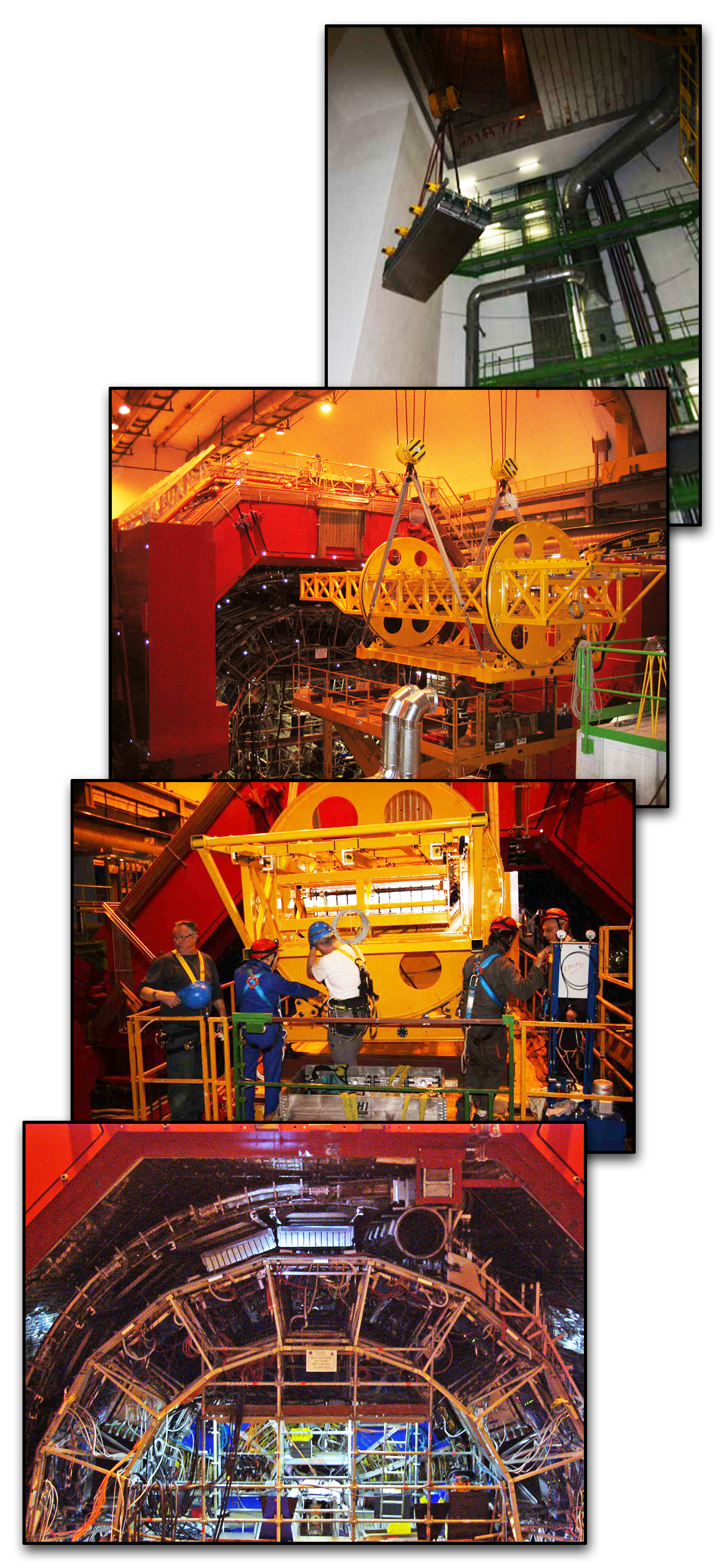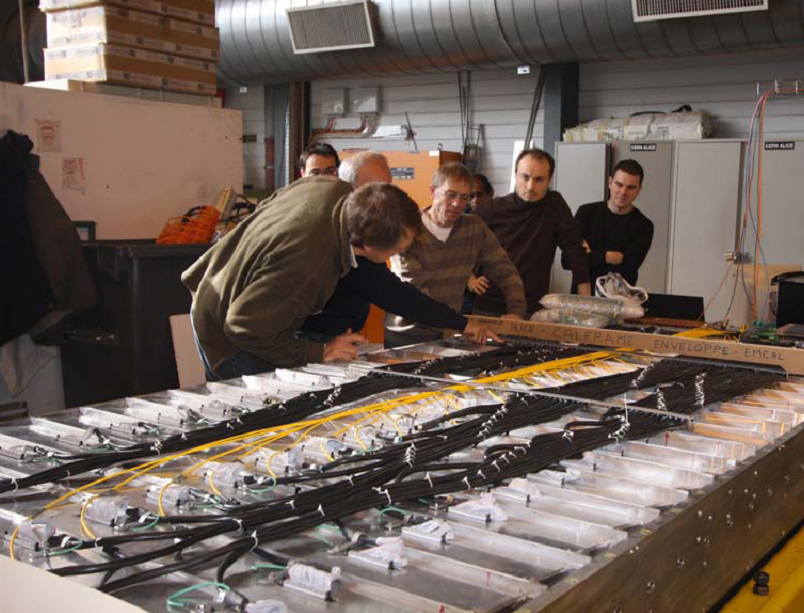Contact: Paul Preuss
ALICE, A Large Ion Collider Experiment at CERN’s Large Hadron Collider (LHC), was designed to study what the universe was like when it was less than a millionth of a second old. The giant detector is now one step closer to completion.
“One way to recreate the extreme energy density of the early universe is by smashing massive nuclei like gold or lead together at high energies,” says Peter Jacobs of Berkeley Lab’s Nuclear Science Division (NSD). “Most of the time the LHC will accelerate and collide counter-rotating beams of protons, but for several weeks each year it will collide lead ions instead.” Lead nuclei are more than 200 times as massive as protons; the debris from these high-energy collisions is what ALICE is designed to detect.
An instrument called the Electromagnetic Calorimeter, or EMCal, will help ALICE capture the most revealing events. In late March, 2009, the EMCal Project Technical Coordinator, Joseph Rasson of Berkeley Lab’s Engineering Division, announced the successful installation and testing of two “supermodules,” eight-ton assemblies of lead-scintillator detectors, the first of 11 similar units needed to complete EMCal.
One of the first two detectors was built in the U.S., the other in France and Italy. EMCal is an international collaboration among scientists and engineers from the U.S. and Europe; besides Berkeley Lab, U.S. participants include Oak Ridge National Laboratory in Tennessee, Wayne State University in Michigan, Yale University in Connecticut, and several other U.S. institutions.
The U.S. supermodules are being built at Wayne State University under the direction of Thomas Cormier, a professor of physics there who is also a member of Berkeley Lab’s Nuclear Science Division and leader of the EMCal Project team.
Mimicking the aftermath of the big bang
When the protons and neutrons in energetic lead ions collide, they create a fireball of unconfined quarks and gluons that mimics the superhot, superdense soup that filled the universe about a millionth of a second after the big bang. ALICE will study the interior of this nuclear liquid by recording the jets of particles that scatter back-to-back when pairs of high energy quarks or gluons slam into each other.
One of the rarest phenomena, but one of the most interesting, is called “jet quenching,” the kind of event ALICE’s EMCal is built to find. A heavy-ion fireball may be so large and dense that one of two back-to-back jets – the one that has to travel through the densest regions – may never escape; it is quenched.
Jet quenching was first predicted by theorists in Berkeley Lab’s NSD, and initial evidence for it was found by a team led by NSD experimentalists at the Relativistic Heavy Ion Collider at Brookhaven National Laboratory. It provides a unique probe of the hot matter generated in heavy-ion collisions.
But jet-quenching happens in only a few lead-lead collisions out of millions, and even then is marked by only a few energetic particles among the thousands in a given event. Recording the particle tracks of every collision would overwhelm ALICE’s data-storage capacity; EMCal is designed to be triggered by jet events worth keeping and to signal ALICE within microseconds.
EMCal does the job with a grid of “calorimeter” detectors consisting of alternating layers of thin, precisely formed lead plates and plastic scintillators, stacked in towers and coupled to optical fibers and a photon sensor. The towers are assembled into modules and the modules into supermodules. The entire EMCal detector is a curved structure that covers about a third of ALICE’s circumference, comprising 11 supermodules in all.

The EMCal supermodules are lowered 50 meters below the surface to the cavern that houses ALICE. Within the cramped quarters they can only be installed by using a special insertion tool built by EMCal's French collaborators to cantilever the heavy components into a narrow space between the inner sections of ALICE and its surrounding magnet. They slide the final distance on rails that are part of the support frame. (Click on image for best resolution.)
“EMCal is a late upgrade to ALICE and is being built very quickly,” says Jacobs, a member of EMCal’s Project Management Board. “Full construction approval from DOE came only at the beginning of 2008. So far we have completed one supermodule of the eight that will be built in the U.S. The total DOE funding for the project is $13.5 million. The other three supermodules are being made by our European partners, of which one is also complete.”
Says Rasson, “Each supermodule weighs about eight tons, mostly lead. The construction takes place at Wayne State University – a very labor-intensive job, requiring 100,000 parts to be assembled by hand with high mechanical precision. The first supermodule traveled from Detroit to Geneva under controlled conditions to protect against shock. It was flown across the Atlantic Ocean from Huntsville, Alabama, on a special transport.”
At CERN, ALICE resides in a cavern 50 meters below the surface in France, two kilometers from CERN headquarters in Geneva. The only way EMCal can be installed in the cramped quarters is by working from one end of the giant experiment and inserting the heavy components into a narrow space between the inner sections of ALICE and its surrounding magnet – which cannot bear EMCal’s weight.
A 25-ton support structure for the supermodules was slid into place last year. Installing the supermodules themselves requires what amounts to a kind of steel drawbridge. The eight-ton supermodules are rotated into proper orientation and the steel frame cantilevers them across a gap four meters wide, where they settle onto rails in the support structure.
Full speed ahead
While EMCal is a late upgrade to ALICE, the LHC itself is also later than anticipated. Its first beams were produced in September of 2008, but a few days later a malfunction forced the accelerator to shut down before collision events could be recorded.
“After repairs, the LHC is scheduled to restart in September of 2009, with first collisions estimated for October,” Jacobs says. “The EMCal detector will therefore see the first LHC beam – something that was not foreseen when the project was initially being planned.” It’s hoped that before work on ALICE must pause to get the accelerator ready for restart, two more supermodules will be completed and may be in place.
Then, to make up for lost time, the LHC will run almost continuously through the winter and on into the following year. During this period ALICE will measure proton-proton collisions as a baseline for the lead experiments. When the successful proton run ends, “the lead injection system is all ready to go,” Jacobs says. “We expect the first lead-ion collisions in ALICE in October 2010.”
Besides Cormier, Jacobs, and Rasson, Berkeley Lab participants in the ALICE EMCal Project include Grazyna Odyniec, Mateusz Ploskon, Jeff Porter, Sevil Salur, and James Symons of NSD, and Dennis Peterson of Engineering.
Additional information
More about ALICE is at http://aliceinfo.cern.ch/Collaboration/
More about EMCal, the quark-gluon plasma, and jet quenching is at http://www.lbl.gov/Science-Articles/Archive/sabl/2008/Feb/jets.html
